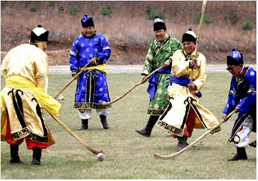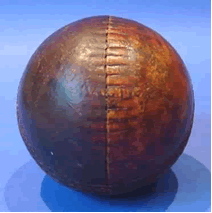History of Field Hockey
Field Hockey is played by 3 million players around the world making it one of the most popular sports around the globe. It began a long time ago, with records showing it as part of the Olympic Games in Ancient Greece as early as 200 B.C., played with a horn and a ball.
Historical Versions of Field Hockey around the World:
 Field Hockey resembles a Chinese game called Beikou that was played one thousand years ago. Earlier records of history speak of similar games using a stick and ball. The Noongar of Western Australia played a similar game called dumbung with bent sticks and a ball of the pear tree’s dried sap. Drawings of men playing the game non-competitively can be seen in the Beni Hasan tombs of Egypt’s Nile Valley from around 4,000 years ago.
Field Hockey resembles a Chinese game called Beikou that was played one thousand years ago. Earlier records of history speak of similar games using a stick and ball. The Noongar of Western Australia played a similar game called dumbung with bent sticks and a ball of the pear tree’s dried sap. Drawings of men playing the game non-competitively can be seen in the Beni Hasan tombs of Egypt’s Nile Valley from around 4,000 years ago.
Around the 13th century, variations of this game were played in many parts of the world. The English called the game Cambuca. It was known as Hurling in Ireland. Shinty was a similar game played in Scotland. The French played Jeu de Mail and Het Kolven was played in the Netherlands.
The 14th century brought the game of Field Hockey to the royalty of England. While most of the royals supported and even played the game, King Edward III was an exception. In 1363, he banned Field Hockey from being played, on the grounds that it was an “idle game.”
Field Hockey in England:
The game as we know it today developed in England in the 19th century by public schools and the Middlesex cricket clubs in London. The Blackheath Hockey Club was the first to organize in 1840 and played a very rough version of the game.
 More than 20 years later, the England’s Teddington Cricket Club members were looking for another game to provide exercise in the winter. They started using a wooden stick to hit their cricket ball on a cricket pitch, with a modified set of association football rules. In 1871, this led to games in Bushy Park, England followed three years later by a set of rules. Other clubs including Surbiton and Richmond joined the game. Rules were established to limit raising the stick above shoulder level and goals must be scored from inside the circle in front of the goal crease. The association formed from these early clubs survived only seven years.
More than 20 years later, the England’s Teddington Cricket Club members were looking for another game to provide exercise in the winter. They started using a wooden stick to hit their cricket ball on a cricket pitch, with a modified set of association football rules. In 1871, this led to games in Bushy Park, England followed three years later by a set of rules. Other clubs including Surbiton and Richmond joined the game. Rules were established to limit raising the stick above shoulder level and goals must be scored from inside the circle in front of the goal crease. The association formed from these early clubs survived only seven years.
In 1886, seven clubs formed The Hockey Association. They continued playing with old cricket balls, instead of the black rubber cube proposed by one of the founding members, the Blackheath Club. The number of players on each team was limited to eleven.
Field Hockey spreads throughout Europe and Beyond:
In the following years, the British army spread the popularity of Field Hockey all through the British Empire. Eighteen ninety-five (1895) marked the milestone of the first international competition in this sport, governed by an International Rules Board. Wales defeated Ireland in this contest three goals to none.
At this time, the game was gaining favor outside Europe. India, one of Britain’s many colonies, took up Field Hockey when British service members introduced them to the game. In 1885, the first clubs in India were organized in 1885 in Calcutta. By the next decade, the Aga Khan tournament and the Beighton Cup were in full force. Field Hockey was made the national sport of India.
International Field Hockey and The Olympic Games:
By 1908, the game was recognized for the Olympics, with only three competing teams – England (the inventors), and their neighbors Ireland and Scotland. It truly took on international status when Belgium and France joined.
Hockey was omitted from the 1924 Summer Olympics held in Paris. This prompted Paul Leautey to lead the establishment of the International Hockey Federation (FIH). The International Hockey Federation was established in Paris in 1924 with Austria, Belgium, Czechoslovakia, Hungary, Spain, and Switzerland as the co-founding members. By 1928, the Olympic Games at Amsterdam permanently included men’s hockey as a competitive sport.
When India competed in the 1928 Olympics, they surprised followers by not conceding any goals through all their games. They dominated the next seven Olympics until 1956, with additional wins in 1964 and 1980. Their neighbors Pakistan, took over as Field Hockey Olympic gold medalists in 1960, 1968 and 1984. In Olympics to follow, Germany, the Netherlands and Australia have shown the most consistency at the top in both the men and women’s games.
Between 1950 and 1970, Belgian Rene Frank worked to develop the Federation and more formally organize the game internationally. In 1970, The Hockey Association and the International Rules Board merged with the International Hockey Federation, which is the dominant governing body to this day.